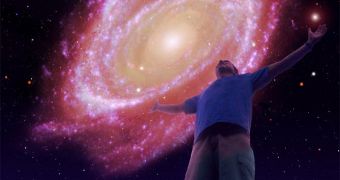For quite some time now, astronomers have been studying the paths of the Milky Way and Andromeda galaxies. Their investigations revealed that the two will collide in about 5 billion years from now, and a new study indicates how the new galaxy might look like.
In order to determine hos such a complex structure will appear to astronomers of the future, the team behind the new work put together a comprehensive atlas of galactic mergers, which covers all the stages involved in such a process.
Usually, when two galaxies cross paths, they first collide and then separate from each other. However, their speeds are usually insufficient to allow them to escape each other's gravitational pull, so they fall back towards a common center of gravity.
The process repeats itself in ever-smaller increments, until the two formations begin to merge. This last for tens, even hundreds, of millions of years. In the end, even the black holes powering the two galaxies might merge with each other.
When it comes to the Milky Way and Andromeda, things turn interesting. Both are monumental spiral galaxies, whose cores are powered up by supermassive black holes. Their collision will give birth to a monster galaxy, one of the largest in the Local Group.
“We've assembled an atlas of galactic 'train wrecks' from start to finish. This atlas is the first step in reading the story of how galaxies form, grow and evolve,” says astronomer Lauranne Lanz.
The expert, who holds an appointment with the Harvard-Smithsonian Center for Astrophysics (CfA), in Cambridge, Massachusetts, presented the atlas at a recent scientific conference, Space reports.
The atlas features infrared images from the NASA Spitzer Space Telescope and ultraviolet data from the NASA Galaxy Evolution Explorer (GALEX) spacecraft. Together, the two observatories captured the most important aspects of galaxy collisions.
“We're working with the theorists to give our understanding a reality check. Our understanding will really be tested in 5 billion years, when the Milky Way experiences its own collision,” Lanz explains.
Interestingly, by the time the two galaxies collide, there may not be an Earth to speak of. Our Sun will enter its red giant phase in about 5 billion years, which means that it will inflate its atmosphere until it becomes larger than Earth's orbit.
The star may even engulf Mars during this stage of its existence. Afterwards, it will expel its atmosphere to create a nebula, while its core will collapse into a helium-burning white dwarf. This remnant will continue to burn for about 3 billion years afterwards.

 14 DAY TRIAL //
14 DAY TRIAL //